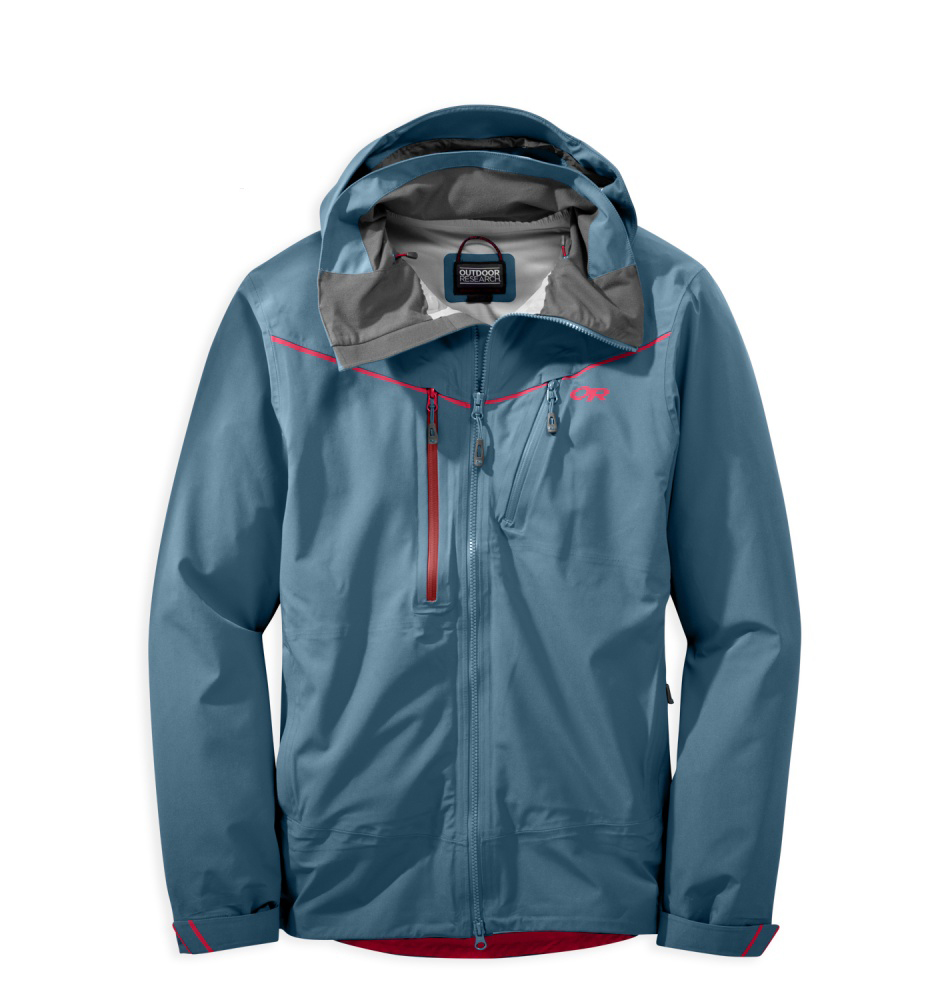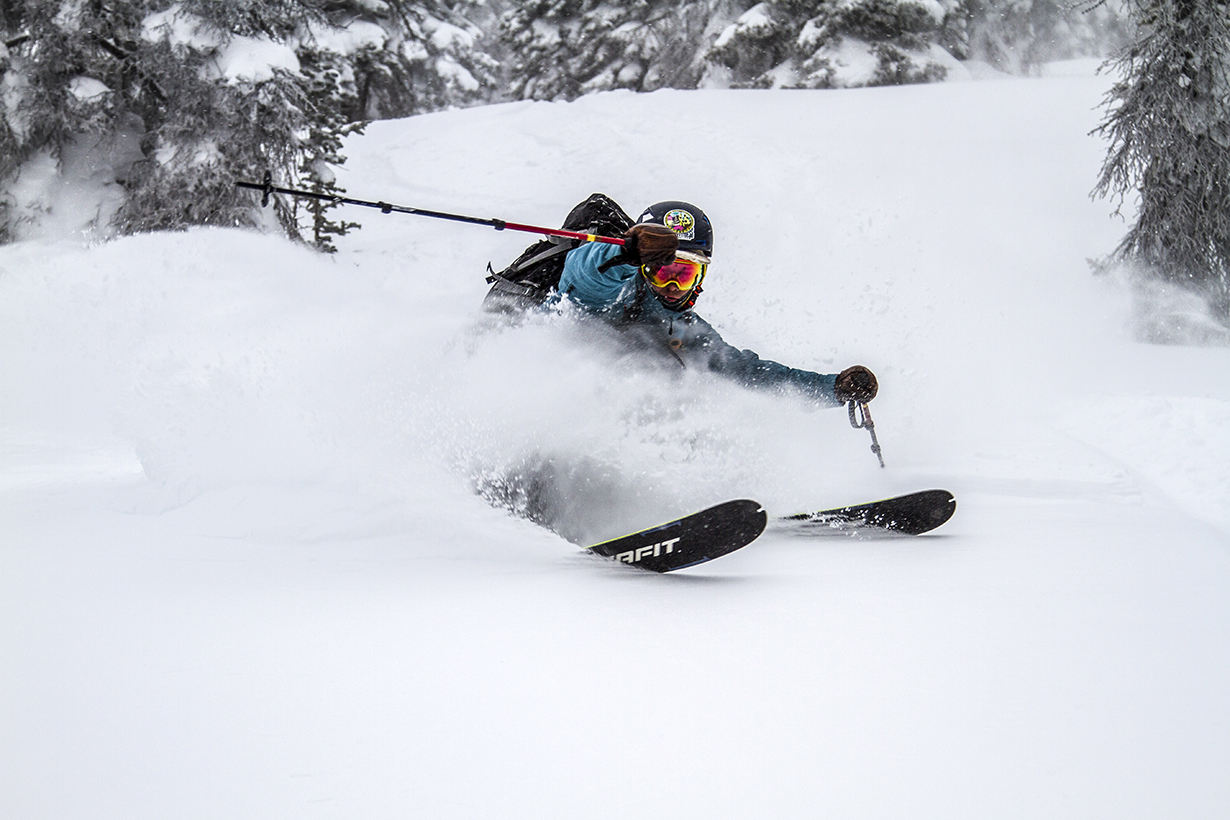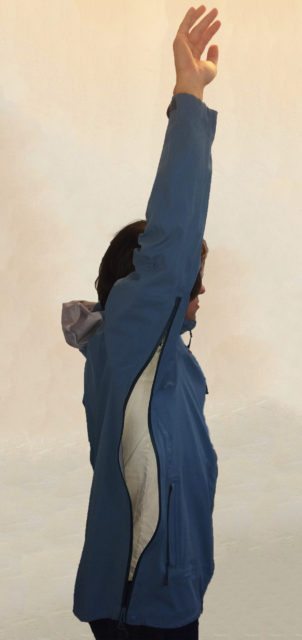
Outdoor Research Skyward Jacket
Size Tested: Large
Stated Weight (size Large): 26.0 oz
Blister’s Measured Weight (size Large): 26.0 oz
Measured Front Zipper Length: 78.0 cm
Stated Features:
- Helmet Compatible Wire-Brimmed Halo-Hood
- Stand-Up Collar
- YKK® AquaGuard® Zippers
- YKK® AquaGuard® Vislon Zippers
- TorsoFlo™ Venting – Hem-To-Bicep
- Two Internal Shove-It™ Pockets
- Dual-Sized Chest Pockets
- Zip Hand Pockets
- Internal Media Pocket
- Internal Front Stormflap
- Integrated Hood Cordlocks
- Brushed Tricot-Lined Collar
- Key Clip
- Double-Separating Center Front Zipper
- Pocket Placement Above Harness or Pack Belt
- Articulated Elbows
- Thumb Drive™ Hook/Loop Cuff Closures
- Elastic Cuffs
- Elastic Drawcord Hem
Fabric:
- Membrane: AscentShell 3 layer
- Face Fabric: 70D stretch plain weave 84% Nylon, 16% Spandex
- Backer: 30D 100% polyester
MSRP: $350
Reviewer: 5’8, 150 lbs
Test Locations: Cameron Pass, CO; Mt. Baker Resort and backcountry, WA; Whistler Blackcomb, Canada
Days Tested: 13
Intro
This year Outdoor Research introduced the Skyward jacket and pants, emphasizing them as highly-breathable pieces designed specifically to suit the needs of backcountry skiers and snowboarders. They are some of the first pieces to utilize “AscentShell,” which is OR’s new air-permeable, waterproof/breathable membrane that the brand claims “will expand your comfort zone by keeping you comfortable and dry, inside and out.”
I’ve spent a number of days this winter in the Skyward jacket testing these claims, and here’s what I’ve found:
Fit
Outdoor Research describes the fit of the Skyward as “Standard,” which sits in the middle of their fit spectrum and is described as “a looser fit for comfort in both technical and casual apparel.” I would say that this is true when talking about ski jackets, as the Large fits me comfortably with room for some layers. I wear a size Medium in most of my midlayers and shirts, but often prefer a looser fit for my ski shells, in part due to style and freedom of movement.
The Skyward is substantially larger throughout when compared to the Arc’teryx Alpha FL, which is a climbing-oriented shell, and is slightly shorter and trimmer than the Arc’teryx Sabre, which has more of what I would call a “freeride” fit. I like the overall fit of the Skyward, as it has ample room for a fleece or midweight puffy, but it does not feel overly baggy. The sleeves are plenty long for my arms, but the length isn’t excessive.
Pockets and Features
The Skyward has a pretty generous feature set for a backcountry ski jacket, with two handwarmer pockets, two chest pockets, an internal zippered pocket, and two stretch drop-in interior pockets. The cuffs are secured with OR’s “Thumb Drive” hook and loop closures, which have not failed during use, although they are not as strong as the Velcro on my Arc’teryx shells. There is no powder skirt on the Skyward, which some people may want to take note of, but as I personally don’t use a powder skirt very often, I did not find this to be an issue.

Although Outdoor Research states that the handwarmer pockets are raised so as to not interfere with hip belts and harnesses, I’ve found that they still get in the way of my backpack’s belt. They are also fairly small, and I had trouble jamming my hands in while wearing gloves like the Hestra Leather Fall Line.
The Skyward uses a two-way YKK AquaGuard Vislon zipper for the main opening, and regular AquaGuard zippers for the exposed chest pockets. The jacket I used was a sample, so the main zipper wasn’t completely finished and had difficulties opening. I therefor won’t be commenting on the center zipper or the interior pockets, and instead, I’ll let David Steele comment on those in his Second Look. But this does bring me to my favorite feature of the jacket: the Skyward’s “TorsoFlo” vents.
I don’t call them pit zips because the two-way vent zipper extends all the way to the hem of the jacket, allowing complete separation of the sides of the jacket. This allowed me to use the jacket like an anorak, but more importantly allowed for a serious amount of airflow inside the jacket. This, combined with the mesh backing on all of the pockets, significantly increased the Skyward’s versatility, which I’ll discuss later in the review.
Fabric
The fabric of the Skyward jacket is very different from the typical, crinkly hardshell material found in most 3-layer jackets. It is very supple while maintaining a degree of heft, and I would relate the hand of it more to a softshell fabric like Polartec Powershield Pro than to a typical waterproof breathable fabric like Gore Pro. I would attribute this to the high spandex content in the face fabric, which makes for a comfortable amount of stretch. I certainly prefer the feel of this fabric over something like the 40-denier Gore Pro used in the Alpha FL.
Besides the face fabric, the Skyward’s AscentShell membrane is of notable importance. As an air-permeable membrane, it falls in line with Polartec NeoShell, Dermizax NX, and eVent. You can learn more about the intricacies of waterproof breathable membranes in our Outerwear 201 article, but the general idea behind air-permeable membranes is that they can constantly allow vapor transfer, as opposed to traditional membranes which require a degree of heat and humidity to buildup inside the membrane in order to begin moving body heat and moisture outside the fabric.
This was my first in-depth experience with air-permeable membranes, and I came away impressed. I never experienced any moisture penetrating the membrane, and found that it breathed very well, which takes us to the next section:
Breathability (and Venting)
I very rarely skin with a shell on. Most of the time, I am perfectly comfortable in just a baselayer or light fleece. But when it is either very windy or snowing hard/wet enough to saturate my other layers, I will toss on a shell. In the Alpha FL, I minimized this as much as possible as I would usually start sweating quickly in the Gore Pro fabric. However, I have been able to head uphill comfortably (without breaking a sweat) in the Skyward while skinning at a leisurely pace in up to 30-degree F weather, and I attribute this to two factors: the AscentShell membrane and the Skyward’s pocket and vent layout.

With all vents and pockets closed, the Skyward breathes slightly better than my Gore-Tex and Gore-Pro pieces (though some of that may be due to the fact that it’s new and not yet clogged up with dirt and gunk), but I still find myself sweating during high-exertion activities like skinning.
However, the Skyward’s massive vents and mesh-backed pockets allow for a great degree of ventilation (especially when there’s any sort of cross-wind), which nicely complements the jacket’s air-permeable membrane. As a result, I have been more comfortable skinning in the Skyward than with any other waterproof breathable jacket.
NEXT: Hood and Collar, Durability, Etc.

Nice review.
Removable hood, or fixed?
Thanks Tom!
And good question – the hood on the Skyward is fixed.
Bummer. I think I’m the only guy left in the world that wants a trim fitting, well-ventilated, technical shell without a hood.
I’m an unapologetic resort skier. No need or desire for a hood, just a really good collar.
Maybe you guys have a few ideas.
Thanks again!